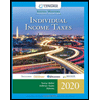
a.
To determine: The federal tax liability.
Personal Taxes:
The personal taxes refer to those taxes which an individual has to pay on his income. This tax is an important source of revenue and the amount of tax is used for the welfare activities of the society.
Capital Gain or Loss:
Whenever a security is bought or sold, there is the difference between the buy price and the selling price. If the selling price is greater than the price at which it was bought, there is a capital gain and if the buying price is more than the selling price, there is a capital loss. The
b.
To determine: The marginal tax rate.
Personal Taxes:
The personal taxes refer to those taxes which an individual has to pay on his income. This tax is an important source of revenue and the amount of tax is used for the welfare activities of the society.
Capital Gain or Loss:
Whenever a security is bought or sold, there is the difference between the buy price and the selling price. If the selling price is greater than the price at which it was bought, there is a capital gain and if the buying price is more than the selling price, there is a capital loss. The capital gains are subject to tax.
c.
To determine: The average tax rate.
Personal Taxes:
The personal taxes refer to those taxes which an individual has to pay on his income. This tax is an important source of revenue and the amount of tax is used for the welfare activities of the society.
Capital Gain or Loss:
Whenever a security is bought or sold, there is the difference between the buy price and the selling price. If the selling price is greater than the price at which it was bought, there is a capital gain and if the buying price is more than the selling price, there is a capital loss. The capital gains are subject to tax.
Trending nowThis is a popular solution!

Chapter 3 Solutions
Fundamentals of Financial Management
- Explain about corporate finance? no aiarrow_forwardSolve it Pat and Chris have identical interest-bearing bank accounts that pay them $15 interest per year. Pat leaves the $15 in the account each year, while Chris takes the $15 home to a jar and never spends any of it. After five years, who has more money?arrow_forwardFinance question subject. solvearrow_forward
- No ai answerarrow_forwardDont use ai solvearrow_forwardThe Short-Line Railroad is considering a $140,000 investment in either of two companies. The cash flows are as follows: Year Electric Co. Water Works 1.................. $85,000 $30,0002.................. 25,000 25,0003.................. 30,000 85,0004–10 ............ 10,000 10,000a. Using the payback method, what will the decision be? b. Using the Net Present Value method, which is the better project? The discount rate is 10%.arrow_forward
- Skyline Corp. will invest $130,000 in a project that will not begin to produce returns until after the 3rd year. From the end of the 3rd year until the end of the 12th year (10 periods), the annual cash flow will be $34,000. If the cost of capital is 12 percent, should this project be undertaken?arrow_forwardWhich of the following would hurt your credit score? Closing a long-held credit card account. Paying off student loan debt. Getting marriedarrow_forwardWhich of the following would be expected to hold its value best during a time of inflation? A certificate of deposit. A corporate bond. A house.arrow_forward
- What is a budget? A spending plan showing sources and uses of income. A limit on spending that cannot be exceeded. The amount of money that a credit card will let youarrow_forwardThe Pan American Bottling Co. is considering the purchase of a new machine that would increase the speed of bottling and save money. The net cost of this machine is $60,000. The annual cash flows have the following projections: Year 1 ........... 2 ........... 3 ........... 4 ........... 5 ........... Cash Flow $23,000 26,000 29,000 15,000 8,000 a. If the cost of capital is 13 percent, what is the net present value of selecting a new machine? I need to see the work. I can't use Excel to solve the problem. Excel doesn't help me solve Part a.arrow_forwardPat and Chris have identical interest-bearing bank accounts that pay them $15 interest per year. Pat leaves the $15 in the account each year, while Chris takes the $15 home to a jar and never spends any of it. After five years, who has more money? Pat. Chris. They both have the same amount. Don’t knowarrow_forward
 Individual Income TaxesAccountingISBN:9780357109731Author:HoffmanPublisher:CENGAGE LEARNING - CONSIGNMENT
Individual Income TaxesAccountingISBN:9780357109731Author:HoffmanPublisher:CENGAGE LEARNING - CONSIGNMENT





